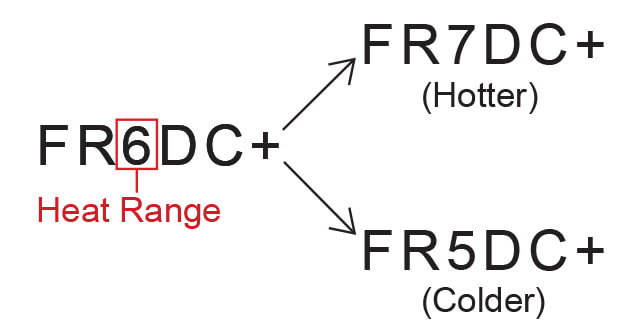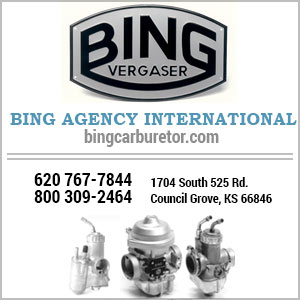1985 R80RT spark plug?
I want to put some new plugs in my bike. I searched a lot of posts without success before asking here.
I have posted mpg and fuel type inquiries and I would like to get the correct spark plug in to do another carb balance.
I pulled the plugs and there was the typical black soot on them. One more than the other. I looked into my Clymer manual and it states a Bosch W7D plug.
The plugs that are currently in the bike are Bosch W7DC. Clymer states that plug is for 1988-on R100rs, r100rt and R100gs.
EME does not carry the Bosch W7D. It does carry the Bosch W7DC. They state that W7DC works on a 1985 R80RT USA.
Is there another plug recommendation, NGK or? that would be worth trying? I can get the W7D on Fleebay but would like to hear suggestions or direction that would be the best application. Thank you in advance.
I can’t say if the Clymer manual is giving you the correct plug for your R80, but if so, the old Bosch plugs are still made and distributed ONLY through BMW dealerships. If you go to Bobsbmw.com you can find the correct Bosch plugs. At least the last I knew.
Well, I just looked at Bobsbmw, and the W7DC is what they have and what they say is correct for your bike. The “C” must be copper core? perhaps? As long as it IS NOT a “WR” resistor plug. Can’t use resistor plugs.
NGK BP7ES works well for me in most models. That's a protruded (or extended) tip in 14mm, extended heat range 7, non-resistor plug. (In NGK-speak, an added "R" denotes an internal resistor.)
I see a lot of bikes come in with heat range 8, and that is WAY too cold for Airheads. Heat range 7 works great in almost all air-cooled engines I've worked on over the last 30 years. You will see some late-80's bikes during the strict EPA carburetion years (before they went to water cooling) that manuals say require heat range 6, but that is WAY too hot for engine longevity and even moderate performance. After 1983/84 you are MUCH better off to install the heat range 7 plugs and then re-jet the carbs to the older standards to put some color on the plugs.
Within the last several months, NGK announced the end of non-resistor plug production. This since cars mostly use Resistor type plugs now. But you should still be able to find BP7ES at local auto parts stores. If you had to buy NGK BPR7ES, I'm not sure what you'd do with your resistor plug caps. That's for smarter, younger minds than mine to figure out.
Owning an old Airhead is easy.
Keeping an old Airhead running great is the true test.
On the Euromotoelectric site they state that an NGK plug in the 6 heat range is the correct plug for a 1985 r80rt. I ordered 2 of them and after rebuilding the carbs paying close attention to reassembly and changing the idle mixture screw to a number 45 verses the 50 that was in place prior to rebuild I had hopes of the bike would begin to run well along with better mpg that was at aprx. 30 mpg. I put a new choke cable in as the old one was rusted and frozen in the plastic unit that operates the two separate choke cables in place. Roughly set the mixture screw 1 turn and rode the bike about 10 miles. seemed to run well. Brought it back and put the old NGK 7 heat range plug in and rode another 10 miles to compare. My perception was that it ran better with the 7 heat range plug. Parked the bike for about 2 hours and went to start it up and it would not start. Choke did not help. Replaced the 7 range plugs with the 6 range and it started with a bit of a struggle. The choke seemed to hinder instead of help the bike run.
So I took each plug out one at a time and shorted them to see if both were sparking. They were both firing but it seemed like a small white spark and not the big bright blue spark that the Clymer manual states.
If the spark is under producing would this be attributed to a weak coil, bad electric ignition unit, bean can magnets hanging up or?
30,000 miles on my bike that obviously sat for different periods. Past owner said he'd put a new timing chain in and taking his word for it I'm looking for suggestions on tracking down what it is to get the bike running correctly. I've had a few airheads in the past that seemed rock solid. I've had BMW Ks and oil heads with electronic fuel injection that were all great bikes.
Hoping I can actually find the problem spot, fix it and enjoy riding it as I know it's capable of. Replacing parts in hopes that the fix will happen can be costly, time consuming and a bit frustrating.
Apologize about venting, but it feels better than continuously being disappointed after long hours chasing potential fixes. Thanks in advance for any help in regaining my sanity and composure.
Your starting issue was not a plug problem, but most probably a lean fuel condition. By 1977 the EPA was demanding more strict emissions control, which increased by the year. And for many motorcycles with carbs that meant running lean and using "hot" plugs.
Understand that the EPA is concerned only with emissions, not running or starting or any thing having to do with performance. They could care less if your vehicle ever ran again, they are only happy when vehicles meet their own (sometimes impossible) specs. Running so lean causes multiple issues, and starting is where it shows up for most users. (This super lean requirement is what finally led to electronic fuel injection on all vehicles, and is even appearing on the latest lawn mowers !!)
You'd do well to get a manual and compare the carb jet sizes between 1985 and the earlier models. Earlier models had more lax settings, which are always more "rich". Haynes is one manual I know that breaks down the jet sizes over the years, but I understand that Bing also has that information available too.
I think you'll see that your starting jet (the smallest one) is a #37 or #38, while most of the older bikes are running #45. Even a #40 would bring a big improvement to your issue. These simply screw in from the bottom, once the float bowl is snapped off. No other disassembly is required.
Hope this helps.
Owning an old Airhead is easy.
Keeping an old Airhead running great is the true test.
Thank you for your response. Your saying the starting jet. Is that also called the main jet? Can't find Bing reference to a starting jet. You said they screw in from the bottom after taking off the float bowl, however there is a small brass jet? in the bowl itself. Just wanted to confirm what you are calling the starting jet. EME has various main jet sizes to choose from.
Thanks for all your help!
John Young
The book is calling it the Pilot Jet. Some bikes will call it the Starting Jet or the Slow-speed Jet. They are one and the same. Just going by the numbers, I would have hoped you understood.
I'm now finally able this morning, to consult my reference material. I see that....
>> All R80 models used a #50 Pilot Jet, until May 1993 when it was reduced to a #45.
>> The big difference was in the Needle Jet. It went from a 2.66 in 1979 models, down to a 1.32 in the US by May 1983.
Those 2 jets are your starting issue. (For a comparison, please note that even the lowly R65 and R75 ran a 2.66 needle jet.)
Take your carbs fully back to the 1979 spec for all jet sizes and your bike will start and run better. Your fuel mileage will not be hurt. Your overall performance will GREATLY increase, which means your ability to pass (overtake) other vehicles will also improve.
Hope this helps.
Owning an old Airhead is easy.
Keeping an old Airhead running great is the true test.
@wobbly Thank you for the clarification. Appreciate your help and knowledge. If you ever need help with your golf swing I'm your guy. Otherwise I still owe your retirement fund compensation for past and present help.
Just a thought, I have much riding gear. I'm 6' 175 lbs for reference. Camping equipment and a few scattered motorcycle parts and what is called farkles? ( kind of a goofy word) for different BMW bikes. Most are for early K bikes, Anyway, just a long shot, but if there is something I have that you might be looking for it's yours.
John Young
@john-young Thanks, I have a man cave fully stuff I'm trying to pawn off myself, ever since I stopped riding.
I will swap riding gear for vintage mechanical clocks !
Owning an old Airhead is easy.
Keeping an old Airhead running great is the true test.
@wobbly I originally did have the #50 pilot jet that I replaced with a #45 after consulting the Clymer and Haynes manuals. I did not change the needle. I recall that it was on the #3 position. Can you tell me if the needle jets are interchangeable with my existing throttle slide? With EPA regulations and ethonal introduced into fuel complicating carb tuning, going back to older settings does make sense.
Posted by: @john-young@wobbly I originally did have the #50 pilot jet that I replaced with a #45 after consulting the Clymer and Haynes manuals. I did not change the needle. I recall that it was on the #3 position. Can you tell me if the needle jets are interchangeable with my existing throttle slide? With EPA regulations and ethonal introduced into fuel complicating carb tuning, going back to older settings does make sense.
Some thoughts and ideas...
• You went "lean" then on the Pilot Jet. A larger number is more fuel, thus a more "rich" condition.
• I did not ask for a change in the Needle, I asked for a change in the Needle Jet; two wholly different things. The Needle changes the mixture by shape and clip setting. It is mounted in the slide. The Needle Jet changes mixture by inside diameter. It is mounted in the carb body, just above the Main Jet.
• Of course Bing made Needle Jets are interchangeable.
• There's a dual issue going on inside your engine. Not only are lawyers tinkering with your mixture settings, but ethanol fuel has much less energy. So your bike is suffering from 1) Much Lower quantity, of 2) Much Lower energy. It's a wonder they even ran.
If you know a Harley owner that bought a new bike, they were probably advised to buy the "Screaming Eagle" carb before even taking the bike off the showroom. Harley had the same problem... too lean under EPA regs to run correctly. But Harley could not sell a "richer" mixture carb, so they formed a shell corporation which sold an "after-market" carb, jetted for what the engine really wanted. Harley, being vehicle maker, had to comply with the law, but Screaming Eagle, being a accessory maker, did not.
Owning an old Airhead is easy.
Keeping an old Airhead running great is the true test.
Bing has a web site. They have both parts and technical support. Parts tend to be cheaper from BMW sources though. Anyway here is a listing for all the jets for Bing carbs on BMWs. The needle and needle jet are wear items especially on later airheads. Airheads tend to spend most of there lives running on the needle jet for most people. If you are having runnability issues, I would seriously consider rebuilding the carburetors with new needle and needle jet.
I was talking about "jetting" for mixture.
But what Frank has added is also true. Due to the intake pulse, there is a "hammering" effect on the Neddle and Neddle Jet. Those should be replaced as a pair every 10 years or so. The Needle Jet wears oval due to this hammering, thus increasing the flow of fuel and enrichening the mixture.
Owning an old Airhead is easy.
Keeping an old Airhead running great is the true test.
Examples of readings
- BC – Thread diameter is 14mm
- P – Projecting insulator type
- R – Resistor
- 5 – Heat rating of 5
- E – Thread length is 19.0mm
- S – Standard type
- 11 – Plug gap is 1.1mm
WR8AC
- W – Thread is 14mm x 1.25
- R – With suppression resistor
- 8 – Heat rating is 8
- A – Thread length is 12.7mm
- C – Electrode material is Copper

- Light tan spark plug: Good mixture.
- Dark brown or Black Spark Plug: Too rich
- Black, oily Spark Plug: Oil fouled (see valves or piston rings.)
- White, no color on spark plug: Too lean.
- Good running conditions: If everything is good, the spark plug should have a tan/light brown color.
- Rich running conditions: If your engine is running too rich, the spark plug will be black and sooty.
- Lean running conditions: If your engine is running too lean, the spark plug will be white.
- If the spark plug is black and oily, they are oil fouled.
If your motorcycle does not seem to be running right, take a look at the spark plugs.
Whenever you are rejetting or tuning your carburetors, a plug chop can take away a lot of the guess work.
Identifying BOSCH Spark Plugs
| Letter | Hex Size | Thread Size |
| D | 20.8mm | 18mm x 1.5mm |
| F | 16mm | 14mm x 1.25mm |
| H | 16mm | 14mm x 1.25mm |
| K | 14mm | 14mm x 1.25mm |
| M | 26mm | 18mm x 1.5mm |
| T | 16mm | 10mm x 1mm |
| U | 16mm | 10mm x 1mm |
| V | 14mm | 14mm x 1.25mm |
| W | 20.8mm | 14mm x 1.25mm |
| X | 17.5mm | 12mm x 1.25mm |
| Y | 16mm | 12mm x 1.25mm |
| Z | 14mm | 12mm x 1.25mm |
Design Type: W R 6DC+
| Letter | Description |
| B | Water-tight, for shielded ignition cable 7mm dia. |
| C | Water-tight, for shielded ignition cable 5mm dia. |
| E | Surface gap spark plug without ground electrode |
| G | Surface gap spark plug with ground electrode |
| H | Half thread |
| L | Surface air gap spark plug |
| M | For motor sport |
| Q | Quickheat |
| R | With interference suppression resistor |
Heat Range: WR 6 DC+
| Number | Heat Range (Hot -> Cold) |
| 12 | Hottest |
| 11 | |
| 10 | |
| 9 | |
| 8 | |
| 7 | |
| 6 | |
| 5 | |
| 4 | |
| 3 | |
| 2 | |
| 09 | |
| 08 | |
| 07 | Coldest |
Thread Length: WR6 D C+
| Letter | Total Thread Length | Thread Length | Insulator and Tip Projection |
| A | 12.7mm | 11.2mm | 1mm |
| B | 12.7mm | 11.2mm | 3mm |
| C | 19mm | 17.5mm | 1mm |
| D | 19mm | 17.5mm | 3mm |
| E | 9.5mm | 1mm | |
| F | 9.5mm | 3mm | |
| G | 12.7mm | 4mm | |
| H | 19mm | 17.5mm | 7mm |
| K | 19mm | 17.5mm | 4mm |
| L | 19mm | 17.5mm | |
| M | 26.5mm | 25mm | 3mm |
| N | 26.5mm | 4mm | |
| S | 26.5mm | 5mm | |
| T | 26.5mm | 7mm |
Electrode Material: WR6D C +
| Letter | Description |
| C | Copper |
| E | Nickel-Yttrium |
| P | Platinum |
| S | Silver |
| I | Platinum-Iridium |
Version: WR6DC +
| Letter | Type |
| R | Burn-off resistor |
| S | 0.7mm gap |
| T | 0.8mm gap |
| U | 1.0mm gap |
| V | 1.3mm gap |
| W | 0.9mm gap |
| X | 1.1mm gap |
| Y | 1.5mm gap |
| Z | 2.0mm gap |
| + | Super Plus Technology |
| Extra Prefix Letters: | |
| D | 2-Ground electrodes |
| T | 3-Ground electrodes |
| Q | 4-Ground electrodes |
- 27 Forums
- 1,900 Topics
- 10.8 K Posts
- 2 Online
- 5,936 Members





